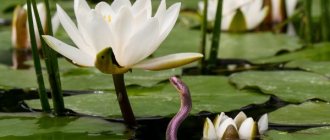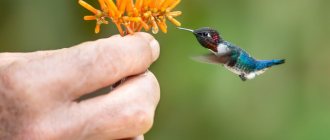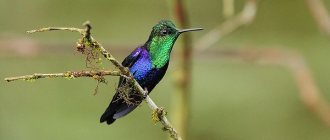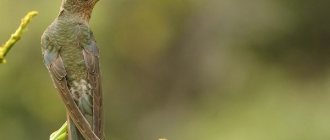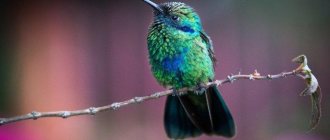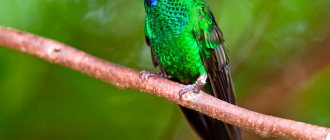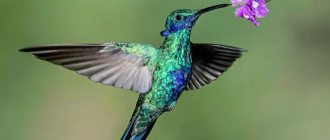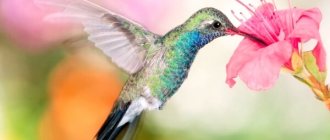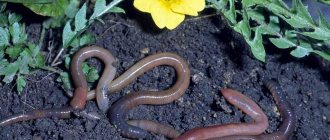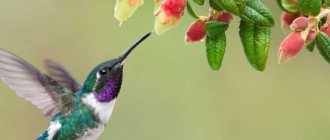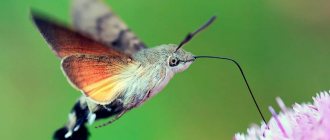Without a doubt, the hummingbird is familiar to every person in the world. Some people saw it on television, and some of us simply came across the little miracle bird in a nature magazine. By the way, as part of the school curriculum in our country, this bird is studied as a mysterious phenomenon of life that lives on the territory of the hot continents of the planet: South and North America, on the island of Cuba. Based on all this, we can definitely say that the bird is known everywhere, from young to old. Several years ago, information appeared in the press and on social networks that a hummingbird had been spotted in the Krasnodar region of Russia. Whether this is so and how reliable the fact of the existence of a tropical winged individual on the territory of our country is, we will try to figure it out within the framework of today’s material.
Appearance
The main “control lever” of a hummingbird is its wings. A complex structure consisting of ten (less often nine) large flight wings and six small ones - short in length and almost completely hidden under the large ones. Due to the enormous frequency of movement, it is almost impossible for the human eye to see the strokes themselves. They merge into one continuous blinking shadow.
Too active mobility of the wings is compensated by weak and underdeveloped legs. Birds practically do not walk on the ground, spending all their time in the air, so they do not particularly need support. Sometimes they can sit on the ground, twigs or flower stems, but they do not have an urgent need to hold tightly to hard surfaces.
The long thin beak and forked tongue help obtain nectar. Moreover, the length of the tongue corresponds to the size of the beak. The structure of the beak includes an upper part that completely covers and protrudes beyond the edges of the lower segment.
Interesting Facts
Hummingbirds are unique birds that differ from other bird species not only in size. They differ in other characteristics, such as:
- These are the smallest vertebrates.
- These are the only birds that can fly in any direction.
- These are the most voracious birds living on our Planet.
- Their heart beats at a rate of up to 500 beats per minute at rest and up to 1200 beats when the bird is in flight.
- These birds, the frequency of whose wing movements are inaccessible to any other species of birds.
- The heart volume of hummingbirds is almost a third of the size of their body.
Nutrition and character
The main food of hummingbirds is flower nectar collected from various plants. The bird flies close to the flower, “stops” in the air, plunges its long nose inside and sucks in the honey liquid with swallowing movements. In addition to nectar, small insects are used, which are caught on the fly or caught in buds, webs, grass or leaves.
To maintain good physical shape and be energetic, hummingbirds have to absorb a simply enormous amount of food, three times its actual weight. Thanks to a fast metabolism, the body manages to maintain normal body temperature and also remain highly active throughout the day.
Being by nature very energetic, agile and mischievous, birds would ideally be classified as choleric on the “human” scale of temperament. You cannot deny her courage and fearlessness. These character traits are especially evident during the period of feeding the chicks, when the small but very proud fighter is ready to attack even snakes and tarantula spiders who have decided to feast on easy prey.
Selfishness and authoritarianism play against the creation of strong family ties. As a rule, hummingbirds are solitary and even in flocks they retain their individuality, not being peaceful or compliant. Conflicts and disagreements often arise in the bird community.
How long does this tiny miracle live?
Unfortunately, the hummingbird only lives for 9 years, and this is not surprising given its lifestyle. But how much benefit it brings, because the help in pollinating plant flowers is simply invaluable. We can say that she is as irreplaceable as bees.
Just imagine if all the bees and wasps, which pollinate plants and help them bear fruit, disappear. Then people will die of hunger. And this can happen, look at what they are doing to nature, how the surrounding ecology is deteriorating due to garbage, chemical waste and air pollution.
It has already been scientifically established that pollinating insects and birds are reducing their populations every year.
Due to climate change, hummingbirds began to be found not only on the American continents, but also in other countries with suitable conditions. For example, in Crimea or Kazakhstan, even in some warm regions of Russia.
The most unusual species of hummingbird is the swordbill, its nose is as long as its own height. Therefore, it does not have to fly close to the flower itself, as long as its beak reaches it.
Habitat and migration
There are more than 300 species of hummingbirds, and most of them are found in South America and southern North America. Birds prefer a sedentary way of life, feeling great in a humid climate where there are forests, mountain meadows and plains with flower fields.
The only exceptions are ruby-throated hummingbirds living in Canada. Due to the harsh climate, they are forced to migrate during the winter, making long flights to Mexico. Before migration, the intelligent bird's body accumulates up to 72% fat in its body, which is much more energetically efficient than carbohydrates.
The need to cross the sea forces the birds to cover a distance of about 1000 km without a break, which takes up to 20 hours. It is not difficult to guess that in terms of endurance they will give odds to any other representatives of the fauna, despite their tiny and almost weightless size.
Natural enemies
Due to their speed and size, hummingbirds have few natural enemies. But tree snakes and large spiders are very dangerous for them. However, the biggest threat to the hummingbird population comes from humans hunting for the colorful feathers.
Photo: goodfon.ru
Swift (50 photos): description of the bird, what it eats and where it lives
Are there hummingbirds in Russia?
This question interests many lovers of flora and fauna, and from time to time there are reports in the press and social networks that someone has seen a small, nimble bird in the Krasnodar Territory, Crimea and even the Far East. In fact, such information should not be trusted; hummingbirds are often confused with moths and butterflies - for example, the great hawk moth.
Officially, ornithologists have recorded only one case of the presence of the buffy hummingbird in Russia. It was 1976, Ratmanov Island. Unconfirmed information also exists about Wrangel Island, as well as mainland Chukotka. Surprisingly, the five-gram baby is able to survive at temperatures of -20 °C.
Reproduction
Family traditions are an empty phrase for hummingbirds. They are solitary by nature and rarely form pairs. Moreover, all care for the offspring falls entirely on the fragile “shoulders” of the female. The male either does not take any part in feeding and raising the chicks at all, or shows care very indirectly. All he can do is protect the territory from potential danger.
The bird's nest is built from soft materials at hand: tree bark, pieces of moss, scraps of cobwebs, dry blades of grass, etc. It is usually attached to branches or forks of branches, less often to hard surfaces such as rocks and concrete. The design is made deep, which creates the impression that the female is hanging in the air.
Typically, a hummingbird lays 2 eggs, which look like peas. The weight of each of them barely reaches 2 grams. The incubation process lasts 15-19 days, and nature has determined the time for raising offspring to be about 20-25 days. During this period, naked, blind and helpless chicks turn into full-fledged adults, capable of independently taking care of themselves.
The average lifespan of birds is 9 years. In captivity the figure is much lower. This is because for proper nutrition it is not enough for them to feed only honey syrup, but they also need to collect nectar from living flowers and plants. Climatic conditions also play a role, plus regular flights over long distances.
Butterfly with beak
There are no hummingbirds in our area, but I didn’t find another more plausible explanation for myself then. Quickly flapping its wings, this creature hovered over the flowers and collected nectar from them with a long curling proboscis. The spectacle was mesmerizing...
This is also interesting
- The hummingbird can safely be called an aerobatics pilot. Nature has rewarded her with the ability to perform incredible tricks in the air - take off sharply in an almost vertical position and land just as quickly, hover motionless in space, and fly with equal agility not only forward, but also backward.
- The ability to fly in place is ensured by the special structure of the wings, which, when flapping, seem to “write out” a figure eight. It is this trajectory that allows you to hang in the air and maintain body balance.
In a second, a miniature but physically developed bird makes 50-80 strokes, and this is far from the limit. In special cases, for example, when a male is swaggering and courting a female, the number of strokes increases to two hundred.- In terms of running speed, the hummingbird can be compared with some sports car. She instantly picks up top speed before she even has time to fly out of the nest, and she can “slow down” just as quickly, landing on a flower stem or branch.
- The average flight speed of a bird is about 50 km/h, while during the mating period the male is capable of accelerating up to 100 km/h.
- Hummingbird bones have the property of not turning into fossils, remaining hollow inside. This makes it possible for ornithologists to study the “history” of the bird’s life during the excavation process. An amazing discovery was made by archaeologists in southern Germany, finding the remains of birds with a similar skeletal structure.
- The age of the putative ancestors of hummingbirds was about 30 million years. The basis for drawing a parallel between modern emerald babies and their prehistoric relatives were such features as a shortened humerus with a characteristic process that allows the wings to rotate around the joint. The find gives reason to think that these amazing birds used to be found outside of America.
Description
The hummingbird-like insect has a rather unusual appearance. The proboscis of an adult is well developed. The front wings have a gray or gray-brown tint. On top of the main color are two bands of rich black color. The outer edge of the front wings is solid. The hind wings are orange, with a narrow dark border. The head is rounded. The abdomen has a wide, although rather flat, hair brush at the end. At the end of the body there is an almost straight horn of pale blue color with a brown ending.
The most common types:
- Wine.
- Euphorbia.
- Poplar.
- Dead Head.
Most of them have bright and unusual colors.
